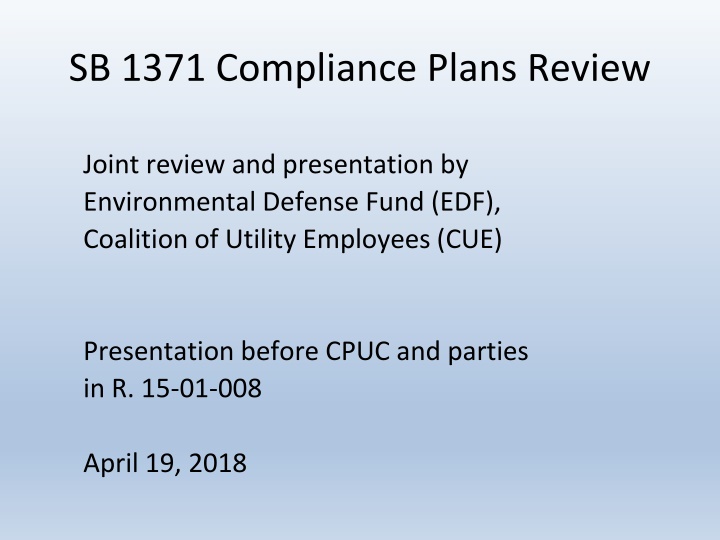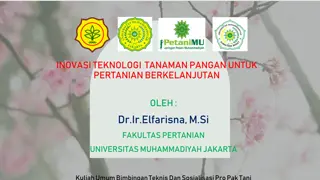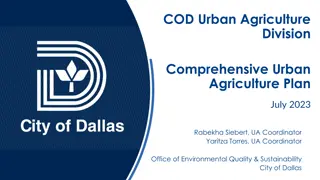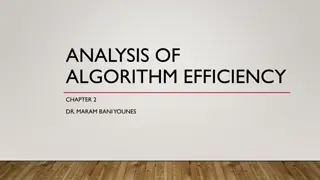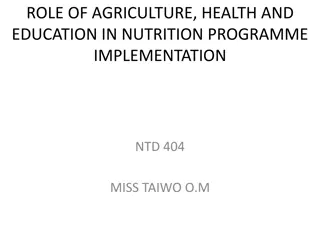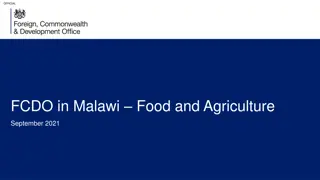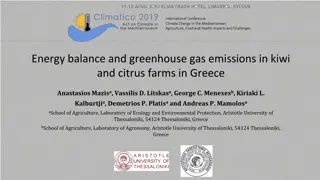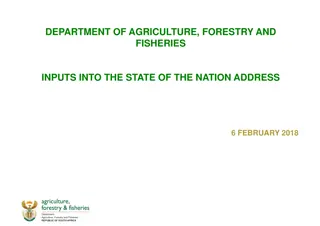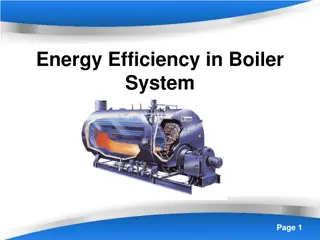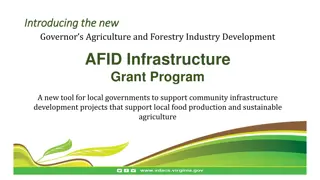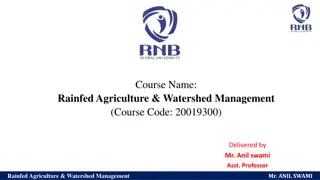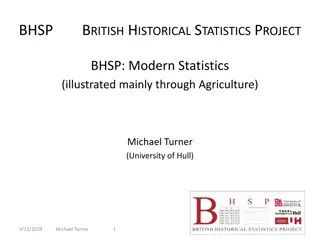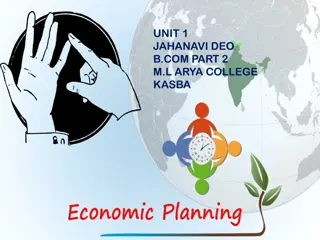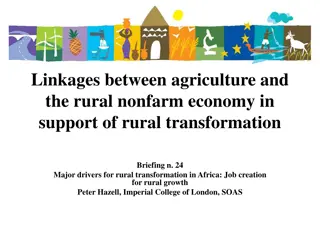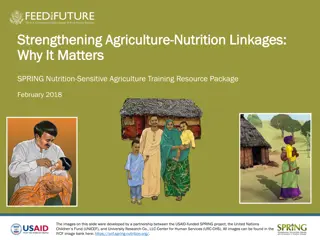Multiple Resource Use Efficiency in Agriculture Systems
This study explores the impact of assumptions on data interpretation in agriculture systems, highlighting the importance of considering unknown processes within ecosystems. It discusses the challenges of assuming relationships between variables and emphasizes the significance of using ecosystem observations to uncover hidden processes.
Download Presentation

Please find below an Image/Link to download the presentation.
The content on the website is provided AS IS for your information and personal use only. It may not be sold, licensed, or shared on other websites without obtaining consent from the author.If you encounter any issues during the download, it is possible that the publisher has removed the file from their server.
You are allowed to download the files provided on this website for personal or commercial use, subject to the condition that they are used lawfully. All files are the property of their respective owners.
The content on the website is provided AS IS for your information and personal use only. It may not be sold, licensed, or shared on other websites without obtaining consent from the author.
E N D
Presentation Transcript
SB 1371 Compliance Plans Review Joint review and presentation by Environmental Defense Fund (EDF), Coalition of Utility Employees (CUE) Presentation before CPUC and parties in R. 15-01-008 April 19, 2018
SB 1371 Policy Implementation A cross-cutting law to achieve 2 goals in Section 975 (b): With priority given to safety, reliability, and affordability of service, the commission shall adopt rules and procedures to achieve both of the following: (1) Minimize leaks as a hazard (2) While giving due consideration to the cost considerations of Section 977, reduce emissions of natural gas from those commission-regulated gas pipeline facilities that are intrastate transmission and distribution lines to the maximum extent feasible in order to advance the state s goals in reducing emissions of greenhouse gases
4 principles of the BP working group 1. Best Practices go beyond technologies and tools to embody a new way of doing things. Policies, practices, and education are as important as new technologies, and may provide additional methane reduction opportunities at lower cost 2. Industry standards for safety and supplemental measures are needed to meet the challenge of eliminating methane emissions to the extent necessary to meet state goals. 3. If we can use the most advanced, technologically feasible, cost-effective measures to further reduce methane emissions beyond established targets, we should. 4. Improved methane detection by itself isn t enough; it should be coupled with better quantification and accurate categorization, and matched with a plan/timetable for mitigation in manners that are cost-effective and effective in minimizing the release of methane.
High level takeaway Based on an in-depth review of SoCalGas and PG&E draft plans, we find: These first-of-the-kind plans have much to be built upon, and There are critical shortcomings that must be overcome before they are adopted to conform with D.17-06-015
Before evaluating the plan contents, there are some high-level themes that EDF and CUE observed
Reduction target D.17-06-015 : the statutory text of SB 1371 supports CPUC s ability to set targets below 40% reduction and does not precludes CPUC from setting firm compliance targets. SB 1381 further supports development of a target Compliance plans shall include information on how each party plans to achieve a 40% reduction below 2013 levels by 2030, what level of reduction would be necessary by 2020, and how they plan to achieve the 2020 reduction level.
Pilot projects D.17-06-015: recognizes that pilot projects may be useful for overcoming challenged with some BPs, but also says that that the outcome of the pilots must allow for review lessons learned and outcomes with the intent to analyze whether full-scale deployment or alternative Best Practices or other research may be desirable. For any proposed R&D and/or Pilot programs, implementation timelines, and evaluation criteria shall be proposed. Approval of pilots will require the submission of cost and emission reduction information
Plan review: SoCalGas
SoCalGas Estimate 16% reduction by 2030
SoCalGas Projects costs of BP implementation/reductions through 2030 Should project over timespan covered by the Plan.
Survey Cycles (BP 15-16) BP 15 provides for a 3 year survey cycle BP 16 requires more frequent surveys of areas with higher risk for leaks
SoCalGas Collapses BP 15 and 16. BP 15 proposes keeps protected steel and state of the art plastic on a 5 year survey and to move non-state of the art plastic pipes and unprotected steel to 1 year survey cycles. Should be 3 year surveys with additional focus on areas with higher risk of leaks
Plans Should Employ the Maximum Feasible Technology D.17-06-16: Plans should provide for the maximum technologically feasible and cost- effective avoidance, reduction, and repair of leaks and leaking components. These should include not only commercially available technology, but also emerging technologies
Leak Detection BP 15-16 Plans that incorporate a combination of walking surveys and robust mobile surveying will be more effective at finding leaks. SoCalGas Plan Relies primarily on walking surveys.
BP 17 Requires use of enhanced methane detection practices, including mobile technology
BP 17 SoCalGas Plan proposes addition of 1 mobile van laboratory to conduct leak speciation 18 month timeline to bring van on line is too long Pilot Studies should include metrics for assessing the effectiveness of technologies
Stationary Methane Detection BP 18 Sensors should be sensitive enough to capture leaks that are environmentally significant even if they would not present a safety issue SoCalGas plan relies primarily on a pilot of sensors that are being installed for it PSEP
Leak Quantification and Mapping BP 20a/20b Plans should incorporate advanced technology for quantification of leaks. Utilities should be employing similar methodology to quantify and map leaks. Mapping should be linked to central database that allows for tracking of leaks over time
SoCalGas Relies heavily on Surface Expression and Tenting. Mapping results should be automatically uploaded to central database to allow for better tracking. Publicly available maps as the utility was one of the first-movers on public mapping, this is an important component. The utility should evaluate whether it has led to increased customer awareness
Leak Repair (BP 21) Backlog of Grade 3 leaks should be repaired as soon as possible and within 3 years Identification of leaks over 10 scf should incorporate mobile methods, in addition to surface expression
BP 23 Replacement of High Bleed pneumatics scheduled through 2022 Cost is $0 BP should be implemented more quickly
Training/Personnel Plans should include training protocols. On-line Training alone may not be enough Job classifications/descriptions should specifically address methane leak detection/repair
Record Keeping Improvements in database management and automation should be tied toward better tracking of leaks and leak repairs. Policies should include an iterative process for assessing success of efforts and implementing changes/improvements.
Benefits of Methane Reduction Benefits should include safety considerations, social cost of carbon in addition to the value of lost gas.
Plan review: Pacific Gas and Electric
PGE High level takeaway: The PG&E plan uses existing approaches which have been key to cutting emissions, and plans to use a wide range of new technology and techniques to further cut emissions. Within the heavy use of pilot projects is a lack of the evaluation of needed metrics to properly evaluate their success and eventual utilization as required BPs.
PG&E Estimate: 17% reduction by 2020, use of new technology to get to 40% - though without any specificity in trajectory or roadmap post 2020. Several mentions of 50% reduction in various categories
PG&E BP 3 Pressure reduction and venting - Like other utilities, there is a commitment to reductions in this activity, but there also needs to be a component of the procedure that involves after-the-fact analysis of conditions that lead to venting and non- conformance with this new policy. There should be a focus on reflection and continuous learning so as to evaluate what went wrong and how improve / manage conditions better in the future
PG&E BP 5 - Potential blowdown reduction goal of 50% (mentioned but not stated as an overt goal)
PG&E BP 15 Gas distribution leak surveys - PG&Es embracing of the 3 year leak survey demonstrates the value and opportunity associated with new technology like mobile mapping. Pilot testing requires a more rigorous look at data and metrics -
PG&E BP 16 Special leak surveys - The focus on vintage pipe appears to be lacking in breadth and focus. The use of predictive and risk based surveys is already well established but given only a passing nod. Pilot testing requires a more rigorous look at data and metrics - -
PG&E BP 17 Enhanced methane detection - PG&E appears to be one of the leading utilities in the nation on using enhanced methane detection equipment which is well described in the document. Pilot testing requires a more rigorous look at data and metrics than what is described -
PG&E BP 18 Stationary methane detection - This is an area where EDF has worked with PG&E on. The utilities focus on high sensitivity sensors is important but must strike the balance between need for deployment and the selection of the perfect equipment.
PG&E BP 19 Above ground surveys - The use of new technology with walking surveys demonstrates a commitment to continuous improvement its not either / or. Again, pilot project must have proper metrics for evaluation -
PG&E BP 20a Leak tracking and quantification - As an early adopter of the Picarro system, the proposal to use high flow samplers seems to be a step backwards: hi-flow samplers may be widely used in the industry, but are seen as yesterday s technology Mobile mapping with quantification has come of age and should be on the table here especially where the utility has already invested so heavily. Direction to the utility to develop and test quantification with what they ve already purchased (Picarro) makes sense - -
PG&E BP 20b Mapping - The timeline for getting this done seems to be unspecific and based on external factors
PG&E BP 20b Find-it / fix it - Super-emitter proposal - something our science team has evaluated and sees as advancing the ball forward. PG&E has created a system based on a rigorous assessment of technological capabilities and leak variability.
PG&E BP 20b Find-it / fix it - Some questions remain, such as whether the data on concentrations be used to inform the other leak surveys? Like other pilots though, the metrics PG&E is planning to capture to aid in evaluation aren t clearly stated such as the incidence of false positives. -
